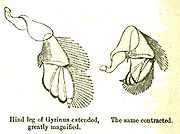
Whirligig beetle
Encyclopedia
The whirligig beetles are a family (Gyrinidae) of water beetle
s that normally live on the surface of the water. They get their common name from their habit of swimming rapidly in circles when alarmed, and are also notable for their divided eyes which can see both above and below water.
They are also known for their grouping behavior, a survival mechanism which helps them to avoid predation. Their places in the group are thought to be determined by a number of factors, including hunger, sex, species, water temperature, age, parasite level and stress level. Research being done on their behavior serves as a model to study the significance of chemical defense
in relation to their position in the group, which relates to such fields as nanotechnology
because the beetle's motion provides insight into the way in which groups of robots might coordinate movements.
Specifically, the beetles make behavioral trade-offs which lead them to different group positions. For example, relatively hungry beetles go to the outside of a group, where there is more food but higher risk of predators. Males are also more likely to be found on the outside of groups (although grouping is unrelated to mating behavior in this family). Individuals swimming against the flow of water in a stream incorporate the needs of drafting into these group positioning decisions. Drafting is when animals swim behind others to take advantage of forward-moving drafts. The determination of forward/backward positioning within a group has been found to be a complex function relating to the: speed of the water, sex of the beetle, and type of predator (bird or fish) most recently observed by a beetle.
They have a bubble of air trapped underneath their abdomens which allows them to dive and swim under the water for a long time.
The family includes about 700 species worldwide.

Water beetle
A water beetle is a beetle adapted to living in water. Water beetles rise to the water surface and take atmospheric air into their tracheal systems. There are approximately 2000 species of water beetles. The rest marine species tend to live in the intertidal zone...
s that normally live on the surface of the water. They get their common name from their habit of swimming rapidly in circles when alarmed, and are also notable for their divided eyes which can see both above and below water.
They are also known for their grouping behavior, a survival mechanism which helps them to avoid predation. Their places in the group are thought to be determined by a number of factors, including hunger, sex, species, water temperature, age, parasite level and stress level. Research being done on their behavior serves as a model to study the significance of chemical defense
Chemical defense
Chemical defense is the use of compounds by plants and animals to deter herbivory and predation.-In plants:Chemical defense against herbivory is common. The production of capsaicin in many strains of bell peppers is one such defense familiar to humans....
in relation to their position in the group, which relates to such fields as nanotechnology
Nanotechnology
Nanotechnology is the study of manipulating matter on an atomic and molecular scale. Generally, nanotechnology deals with developing materials, devices, or other structures possessing at least one dimension sized from 1 to 100 nanometres...
because the beetle's motion provides insight into the way in which groups of robots might coordinate movements.
Specifically, the beetles make behavioral trade-offs which lead them to different group positions. For example, relatively hungry beetles go to the outside of a group, where there is more food but higher risk of predators. Males are also more likely to be found on the outside of groups (although grouping is unrelated to mating behavior in this family). Individuals swimming against the flow of water in a stream incorporate the needs of drafting into these group positioning decisions. Drafting is when animals swim behind others to take advantage of forward-moving drafts. The determination of forward/backward positioning within a group has been found to be a complex function relating to the: speed of the water, sex of the beetle, and type of predator (bird or fish) most recently observed by a beetle.
They have a bubble of air trapped underneath their abdomens which allows them to dive and swim under the water for a long time.
The family includes about 700 species worldwide.

 |
 |
External links
- Gyrinidae Tree of Life

